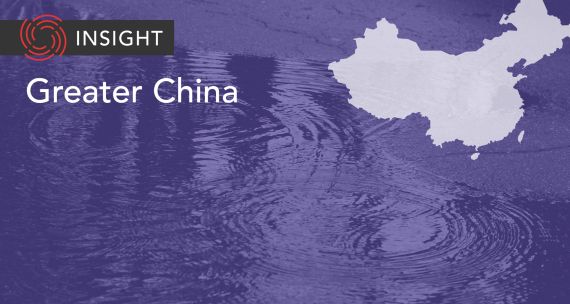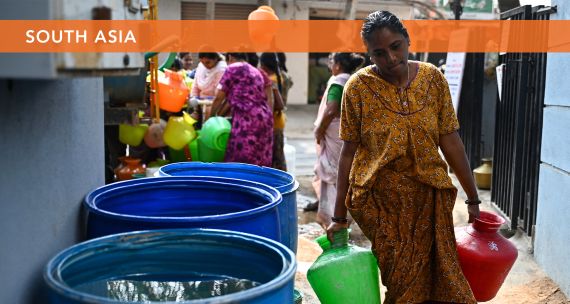Last summer, as drought spread across Western Canada, water was the conversation of the day. Restaurants began providing glasses only on demand, strict watering restrictions were imposed and we heard a lot about innovations like smart shower heads.
Six months later, after decent rains and snowfall, Canadian public attention has died down, but the underlying problem of diminishing supply remains. As savvy futures investors have already realized, water is going to be the new “peak oil.”
The threat of impending severe and widespread water stress is particularly high in the Asia-Pacific region, with a population of 4.3 billion that generates one-third of the world’s GDP. Today, 97 per cent of the region’s population in urban areas and 87 per cent of its population in rural areas lacks access to improved water. A new study by researchers from the Massachusetts Institute of Technology projects that because of climate change, Asia’s “thirsty” economic growth trajectory and its projected population growth, one billion more people there will become water-stressed by 2050.
This has huge implications for global growth and stability. According to UNESCO, more than 80 per cent of global employment is dependent on access to an adequate supply of water and related services. Agriculture and food production, forestry, wood products, pulp and paper, inland fisheries, mining and resource extraction, power generation, textiles, rubber, plastics, and electronics are heavily or moderately dependent on it. Couple this with Pacific Institute research showing that water has been the source of 33 incidents of conflict in Asia since 2000, and a disturbing picture emerges.
The challenges are likely to be particularly severe in China and India, where rapid industrialization and urbanization are making high demands on supply. In China, 63 million people lack access to safe drinking water. The World Water Organization estimates that the water in half of the country’s mainstream rivers and lakes is unfit for human consumption.
The situation may be even more severe in India, where 76 million people lack access. The World Bank estimates that by 2030, 60 per cent of all India’s aquifers will be in critical condition. WaterAID has reported that 80 per cent of India’s surface water is polluted. The governments and populations in both countries are acutely aware of the urgent need for action. Investment in water infrastructure is being prioritized and the search for water technologies is underway.
In this context, Canada has a real opportunity to establish itself as a provider of solutions. Canada is known for expertise in water management. We have carefully anticipated, prevented and resolved water disputes with the United States through the International Joint Commission and our participation in the Great Lakes Commission. And we are home to an exciting group of engineering and consulting companies providing a wide range of products and services to minimize water leakage, maximize efficiency and cleanup contamination. Of course, our record is not pristine: Think of Ontario’s Walkerton tragedy and the contamination plaguing First Nations communities. But we can provide remedies to many of Asia’s water challenges.
Indeed, a few of our experts and a scattering of our companies are already there, selling products and offering advice. Companies like B.C.’s Singer Valve, which designs and manufactures control valves that control water pressure resulting in reduced water leakage, and New Brunswick’s ADI Group, which provides technologies for wastewater treatment, are regarded as pioneers in this field. But the potential for Canadian company engagement is much greater, if we can just clear a few hurdles.
First, our water companies tend to be small. Moving into Asian markets is difficult, as they don’t have the resources to gain market intelligence and build partnerships with governments and businesses.
Second, many of Asia’s clients are subnational governments or large private or state-owned companies looking for systems solutions to complex water problems. They don’t just need a valve or filter – they need an integrated purification or distribution system. They currently look to companies such as Veolia, Suez or ITT Corp., which can deliver holistic solutions. Our companies aren’t big enough to provide the entire package alone.
Third, water deals tend to be expensive and clients often need assistance with financing, or at least a risk-mitigation guarantee. Larger foreign water companies can often provide flexible payment schemes or bankroll demonstration projects in-country that boost a client’s confidence that larger projects can be delivered according to schedule and specification.
These three issues could be addressed through creative public-private partnering. Adapting the model of Ontario’s WaterTap, which helps Ontario companies innovate and get access to markets, Ottawa could provide seed funding for the establishment of a consortium of Canadian water companies from across the country. “Canada Water” could establish offices in target markets and be responsible for identifying opportunities and marketing. It could act as aggregator, allowing companies to work together to provide a “systems solution.”
The Canadian Commercial Corp., Canada’s international contracting and procurement agency, could be designated as the consortium’s prime contractor, negotiating the government-to-government contracts that characterize important parts of water-sector deals. CCC’s involvement could provide the risk-mitigation mechanism.
And finally, Export Development Canada, our export credit agency, could support businesses in the consortium, providing insurance and financial products and services that they might need to enter Asian markets.
The federal government has just issued its new budget with significant money earmarked for clean tech development, innovation and water governance. Catalytic funding to jump-start Canada Water would go a long way in strengthening our reputation as an international leader.
This piece was first published August 8, 2016 in the Globe and Mail.



